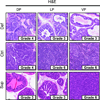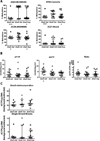Dietary folate deficiency blocks prostate cancer progression in the TRAMP model
- PMID: 21836022
- PMCID: PMC3208799
- DOI: 10.1158/1940-6207.CAPR-11-0140
Dietary folate deficiency blocks prostate cancer progression in the TRAMP model
Abstract
Dietary folate is essential in all tissues to maintain several metabolite pools and cellular proliferation. Prostate cells, due to specific metabolic characteristics, have increased folate demand to support proliferation and prevent genetic and epigenetic damage. Although several studies have found that dietary folate interventions can affect colon cancer biology in rodent models, its impact on prostate is unknown. The purpose of this study was to determine whether dietary folate manipulation, possibly being of primary importance for prostate epithelial cell metabolism, could significantly affect prostate cancer progression. Strikingly, mild dietary folate depletion arrested prostate cancer progression in 25 of 26 transgenic adenoma of the mouse prostate (TRAMP) mice, in which tumorigenesis is prostate-specific and characteristically aggressive. The significant effect on prostate cancer growth was characterized by size, grade, proliferation, and apoptosis analyses. Folate supplementation had a mild, nonsignificant, beneficial effect on grade. In addition, characterization of folate pools (correlated with serum), metabolite pools (polyamines and nucleotides), genetic and epigenetic damage, and expression of key biosynthetic enzymes in prostate tissue revealed interesting correlations with tumor progression. These findings indicate that prostate cancer is highly sensitive to folate manipulation and suggest that antifolates, paired with current therapeutic strategies, might significantly improve treatment of prostate cancer, the most commonly diagnosed cancer in American men.
Figures






Similar articles
-
Mild folate deficiency induces genetic and epigenetic instability and phenotype changes in prostate cancer cells.BMC Biol. 2010 Jan 21;8:6. doi: 10.1186/1741-7007-8-6. BMC Biol. 2010. PMID: 20092614 Free PMC article.
-
High animal fat intake enhances prostate cancer progression and reduces glutathione peroxidase 3 expression in early stages of TRAMP mice.Prostate. 2014 Sep;74(13):1266-77. doi: 10.1002/pros.22843. Epub 2014 Jul 22. Prostate. 2014. PMID: 25053105
-
Bitter melon extract impairs prostate cancer cell-cycle progression and delays prostatic intraepithelial neoplasia in TRAMP model.Cancer Prev Res (Phila). 2011 Dec;4(12):2122-30. doi: 10.1158/1940-6207.CAPR-11-0376. Epub 2011 Sep 12. Cancer Prev Res (Phila). 2011. PMID: 21911444 Free PMC article.
-
Folic acid supplementation and malaria susceptibility and severity among people taking antifolate antimalarial drugs in endemic areas.Cochrane Database Syst Rev. 2022 Feb 1;2(2022):CD014217. doi: 10.1002/14651858.CD014217. Cochrane Database Syst Rev. 2022. PMID: 36321557 Free PMC article.
-
Folate, colorectal carcinogenesis, and DNA methylation: lessons from animal studies.Environ Mol Mutagen. 2004;44(1):10-25. doi: 10.1002/em.20025. Environ Mol Mutagen. 2004. PMID: 15199543 Review.
Cited by
-
A joint effect of new Western diet and retinoid X receptor α prostate-specific knockout with development of high-grade prostatic intraepithelial neoplasia in mice--a preliminary study.Prostate. 2012 Jul 1;72(10):1052-9. doi: 10.1002/pros.22496. Epub 2012 Feb 7. Prostate. 2012. PMID: 22314496 Free PMC article.
-
Superior cancer preventive efficacy of low versus high dose of mTOR inhibitor in a mouse model of prostate cancer.Oncotarget. 2020 Apr 14;11(15):1373-1387. doi: 10.18632/oncotarget.27550. eCollection 2020 Apr 14. Oncotarget. 2020. PMID: 32341756 Free PMC article.
-
The Incoherent Fluctuation of Folate Pools and Differential Regulation of Folate Enzymes Prioritize Nucleotide Supply in the Zebrafish Model Displaying Folate Deficiency-Induced Microphthalmia and Visual Defects.Front Cell Dev Biol. 2021 Jun 29;9:702969. doi: 10.3389/fcell.2021.702969. eCollection 2021. Front Cell Dev Biol. 2021. PMID: 34268314 Free PMC article.
-
The essential role of methylthioadenosine phosphorylase in prostate cancer.Oncotarget. 2016 Mar 22;7(12):14380-93. doi: 10.18632/oncotarget.7486. Oncotarget. 2016. PMID: 26910893 Free PMC article.
-
The relationship between nutrition and prostate cancer: is more always better?Eur Urol. 2013 May;63(5):810-20. doi: 10.1016/j.eururo.2012.11.012. Epub 2012 Nov 15. Eur Urol. 2013. PMID: 23219353 Free PMC article. Review.
References
-
- Gangjee A, Jain HD, Kurup S. Recent advances in classical and non-classical antifolates as antitumor and antiopportunistic infection agents: part I. Anticancer Agents Med Chem. 2007 Sep;7(5):524–542. - PubMed
-
- Gerner EW, Meyskens FL., Jr Polyamines and cancer: old molecules, new understanding. Nat Rev Cancer. 2004 Oct;4(10):781–792. - PubMed
-
- Loenen WA. S-adenosylmethionine: jack of all trades and master of everything? Biochem Soc Trans. 2006 Apr;34(Pt 2):330–333. - PubMed
-
- Cole BF, Baron JA, Sandler RS, Haile RW, Ahnen DJ, Bresalier RS, McKeown-Eyssen G, Summers RW, Rothstein RI, Burke CA, Snover DC, Church TR, Allen JI, Robertson DJ, Beck GJ, Bond JH, Byers T, Mandel JS, Mott LA, Pearson LH, Barry EL, Rees JR, Marcon N, Saibil F, Ueland PM, Greenberg ER. Folic acid for the prevention of colorectal adenomas: a randomized clinical trial. Jama. 2007 Jun 6;297(21):2351–2359. - PubMed
Publication types
MeSH terms
Substances
Grants and funding
LinkOut - more resources
Full Text Sources
Medical

